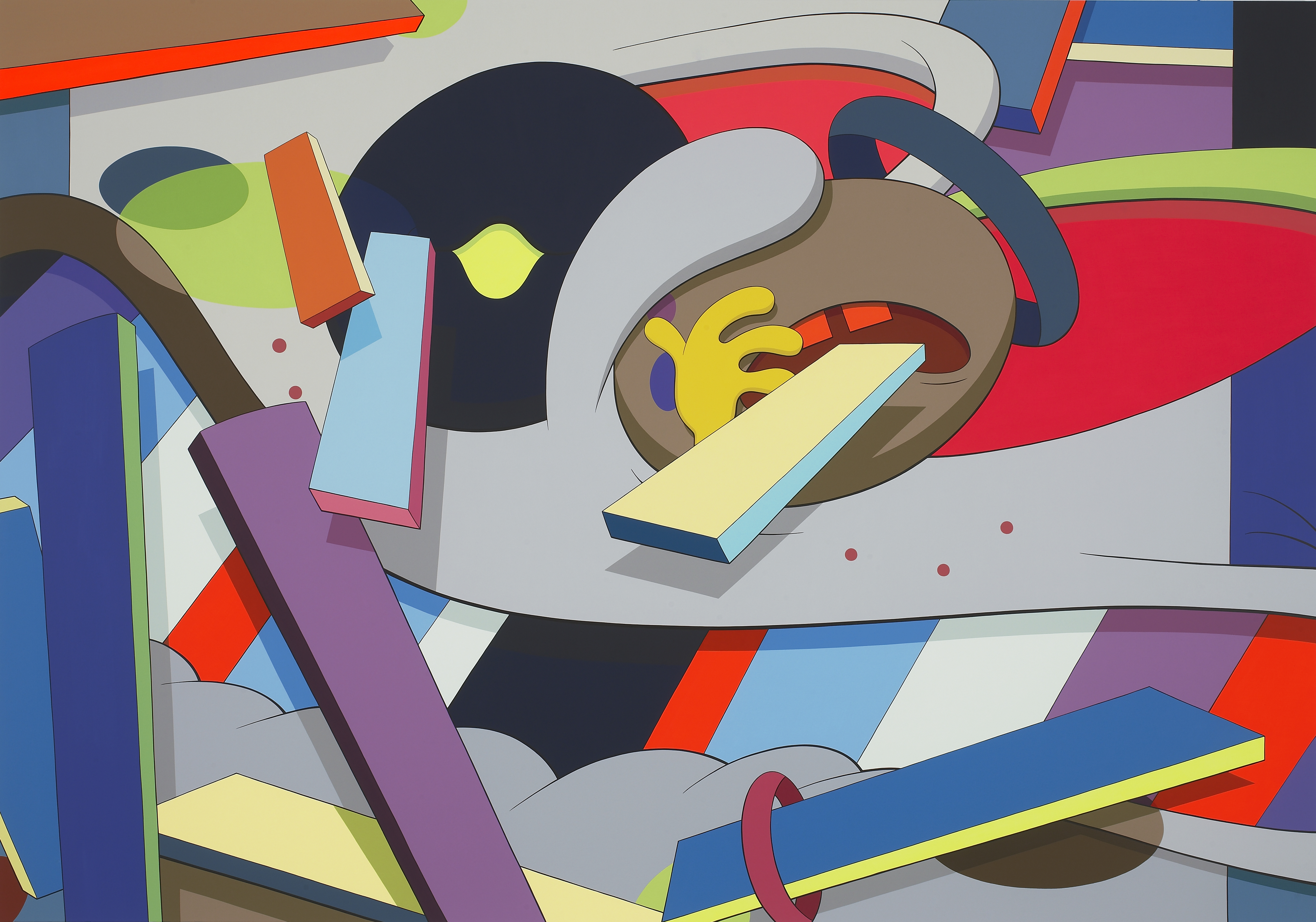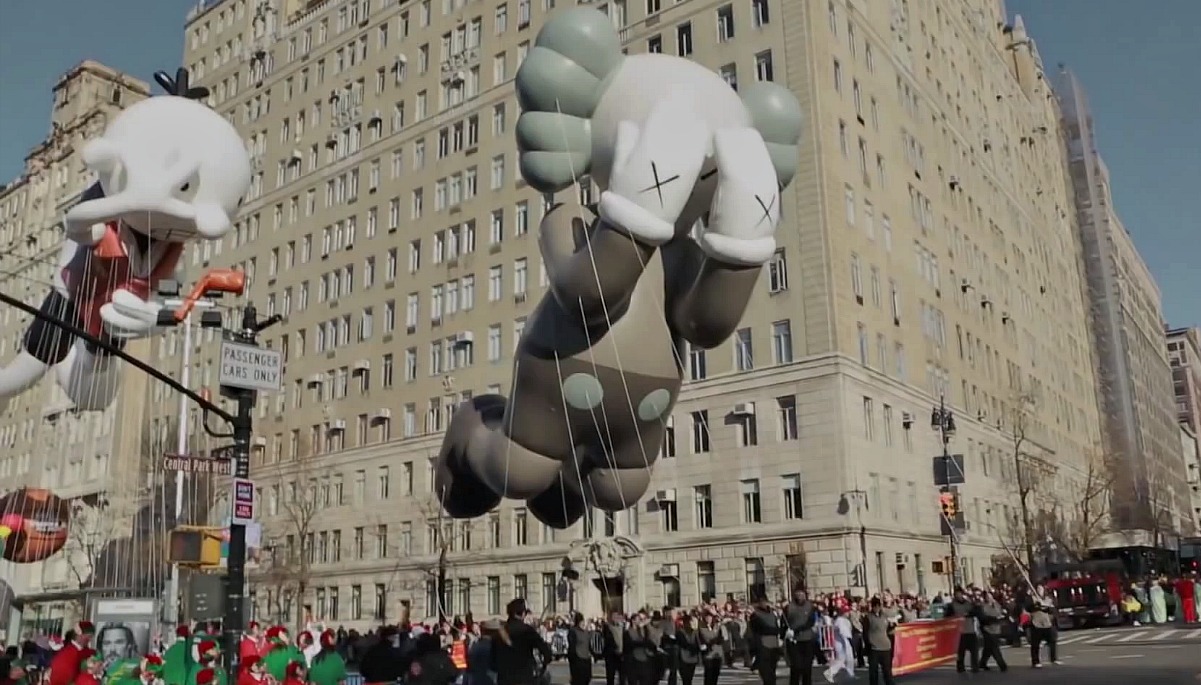KAWS And His Big Little Toys At The Modern
ArtandSeek.net October 21, 2016 109The artist known as KAWS is today’s typical international entrepreneur-artist. The 42-year-old is a graffiti artist-turned-streetwear-designer-turned-toymaker-turned-printmaker-turned-sculptor-turned who knows what’s next? KERA’s Jerome Weeks reports, just to cover KAWS’ career so far, the Modern Art Museum of Fort Worth has debuted a retrospective with more than 200 items. In other words: KAWS is a wildly prolific artist, and the show’s a very big deal in contemporary art circles.
The artist’s real name is Brian Donnelly and the name KAWS doesn’t really mean anything — Donnelly just liked the way it looked and the fact it brought in no immediate associations (like New York Irish — the way Brian Donnelly might). You come to KAWS clean of expectations.

‘Where the End Starts,’ acrylic on canvas, 2011
But KAWS’ most famous creation is a Mickey Mouse-like figure called Companion. Companion was born in the late ‘90s when KAWS was moving from graffiti in New York to creating collectible art toys.
“I was thinking, well, I want to work within the language of toy history,” he says, “and one of the most iconic was Mickey, with his gloves and his shorts, and when you start looking at all those toys, you realize those gloves are on dozens of characters. So the first figure that I made has a Mickey-ish feeling.”
It was an 8-inch-tall toy – with Mickey’s gloves and shoes and button-down britches. But then, how did that limited edition toy turn into entire product lines — including a brand-new set of 10-inch-tall plush toys for this show — and the paintings and the towering sculptures in the Fort Worth Modern’s 20-year retrospective of KAWS’ work?
Curator Andrea Karnes says that distance — what many of us may see separating cute little toy from big serious art — was always on KAWS’ mind. “You may see a monumental sculpture in this exhibition and it looks exactly like the small toys that he does. And the reason is he wants us as viewers to question, why if one thing is a certain size, it’s not art. But if it grows larger and it’s placed on a pedestal, it is art?”
Actually, there IS something to be said for monumentality. It makes an impression. It seems large therefore important. So let’s go even bigger and remove the pedestal. Four years ago on Thanksgiving Day, that little toy-turned-museum-centerpiece became a 40-foot giant floating down 6th Avenue in New York. Matt Lauer announced as Companion hove into view on TV: “Macy’s is proud to present a special balloon created by the internationally acclaimed artist known as KAWS.”
 Millions of American TV viewers may have asked ‘Who?’ Or ‘Daddy, why does Mickey look so sad?’ But by then, many others knew who KAWS was: His toys and t-shirts were being re-sold on eBay for hundreds, even thousands of dollars. And the Modern had already started its relationship with the artist. Karnes had arranged a small FOCUS exhibition at the museum in 2011, which included the painting “Where the End Starts,” which the Modern acquired.
Millions of American TV viewers may have asked ‘Who?’ Or ‘Daddy, why does Mickey look so sad?’ But by then, many others knew who KAWS was: His toys and t-shirts were being re-sold on eBay for hundreds, even thousands of dollars. And the Modern had already started its relationship with the artist. Karnes had arranged a small FOCUS exhibition at the museum in 2011, which included the painting “Where the End Starts,” which the Modern acquired.
Besides, KAWS wasn’t the first artist to design a Macy’s balloon. It was part of the annual ‘Blue Sky Gallery’ program.
“They called me,” says KAWS, “and at first, I wasn’t even certain it was a real phone call. But I knew the artists before me, you know, Jeff Koons and Takashi Murakami, and it just seemed like a great full-circle way of reaching America.”
Great product placement, in other words. The artists he names – Jeff Koons and Takashi Murakami – were two pioneers of doing what KAWS had been trying: mixing pop art, high art and mass-market products. Re-working a pop icon like Mickey Mouse is as old as Andy Warhol. But KAWS’ creations lack Warhol’s chilly detachment, his ironic critique of consumerism. KAWS’ characters are often oddly likable, even chummy. They’re more companionable, as it were, hence their names: Companion, Chum and Accomplice.

‘Companion: Passing Through’ fiberglass, 2010. Photo: Jerome Weeks
In this chummy relationship with pop culture and consumer products, one partly sees the influence of Murakami’s kawaii, Japanese for “cute.” You know, all those smiling Hello Kitty and Pokemon-like figures he’s created. In fact, KAWS flew to Japan in 1999 precisely because, thanks to artists like Murakami, there was less resistance there, less of a divide between museum art and market product.
“In Japan, they were looking at the work,” he says, “and they were more accepting of the commercial endeavors I was interested in.” So it was Japanese companies that came out with his first Kompanion vinyl toys and t-shirts.
At times, we even feel sorry for Companion — like the 16-foot-tall version called ‘Passing Through” that sits, looking a little cramped in one of the Modern’s galleries. He has his head in his hands like he’s imprisoned here. But KAWS explains that’s because he was originally commissioned for a spot in Hong Kong.
“And they told me that for the month of the exhibition that there’d be more than a million people past it,” he says. “And I was just thinking, God, if I was a sculpture that had to be here and gawked all day, I’d be mortified.” (It’s no surprise KAWS is popular in Asia — the Modern’s exhibition heads to Shanghai after it closes in Fort Worth.)
Nowadays, KAWS has designed bottles for Dos Equis and album covers for Kanye West and perfume bottles for Pharrell. This kind of ‘artist as crossover conglomerate’ may be pretty common in the culture market these days. But what’s still difficult is: How do you do it? How do you get from the toy to the sculpture, from the street to the museum store?
KAWS says, for him, the sculptures were always where the toys were headed. He just needed a way to get there. Making huge fiberglass statues with internal steel frames is not cheap: He’d researched the company that used to do Claes Oldenberg’s giant pop-art creations.

KAWS, aka Brian Donnelly. Photo: Jerome Weeks
“There wasn’t really an outlet for me to make sculpture,” he says. “And I thought, ‘Oh, you have to have a patron or some sort of funding to make that happen.’ And so instead of making this one monumental piece, I went toward making 500 of these 8-inch pieces and eventually through the production of my toys and other things, I was able to self-fund my sculptures.”
But Karnes also points to an approach of KAWS that’s always defined his work. Way back when he was a graffiti artist, he wasn’t simply tagging billboards and phone booth posters, covering everything with his name. He liked the ad campaigns on them. He was trying to augment them, elaborate on them – make them more human, more humorous.
“It’s never been about defacing for him,” says Karnes. “It’s been about collaboration.”
KAWS sees himself as a fellow artist in conversation with these images, not appropriating or mocking them but interacting with them. So that’s what he’s done with Mickey Mouse or Snoopy or Star Wars – or the entire wall he’s turned into a freshly painted mural just for the Museum of Modern Art show.
He’s upgraded them. Made them more colorful, made them friendlier.










